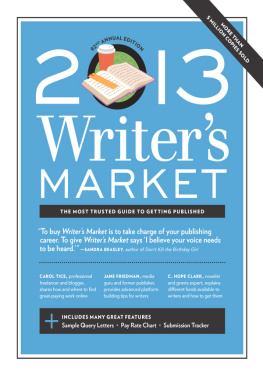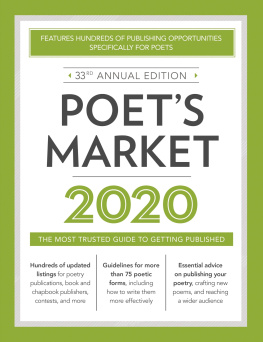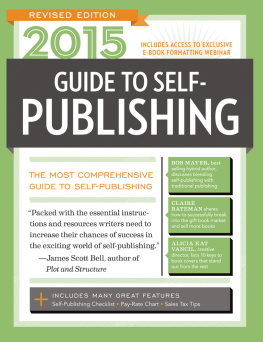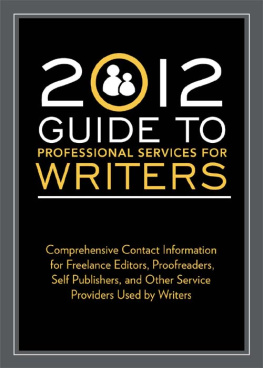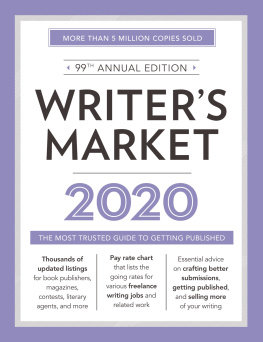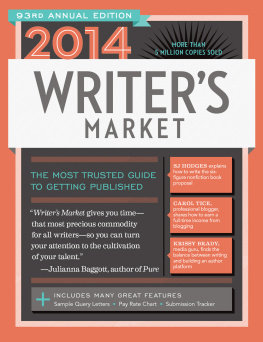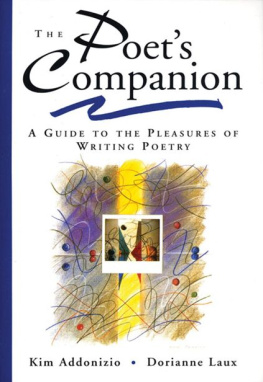Contents
Guide
POETS
MARKET
2016
29th ANNUAL EDITION
Robert Lee Brewer, Editor

WritersDigest.com
Cincinnati, Ohio
CONTENTS
FROM THE EDITOR

Every year, I come to this book with the same goal: Lets make this book more useful for poets than ever! For this years edition, I attempted to pack in more listings than ever for poets in every section: Magazines/Journals; Book/Chapbook Publishers; Contests & Awards; Conferences, Workshops & Festivals; and even Organizations.
This edition of Poets Market still includes articles covering the business, promotion, and craft of poetry, because I believe theres always a need for that extra advice that helps poets find more success than they did before picking up this book. Some of the new articles this year include 6 Ways to Promote Your New Book, How to Take Poetry to New Audiences, and some craft pieces. I may be biased, but I think the Poets Market 2016 is the best edition yet.
That said, Im probably already trying to figure out how to make the next edition even better. If you have any ideas, be sure to send a tweet to my Twitter handle below and leave me a comment at the Poetic Asides blog (URL below). Because as a poet myself, I want this book to help other poets as much as possible.
By the way, dont forget to take advantage of your free poetry-related webinar by heading to http://www.writersmarket.com/pm16-webinar.
Until next time, keep poeming!
Robert Lee Brewer
Senior Content Editor, Poets Market
http://www.writersdigest.com/editor-blogs/poetic-asides
http://twitter.com/robertleebrewer
BUSINESS OF POETRY
HOW TO USE POETS MARKET
Delving into the pages of Poets Market implies a commitmentyouve decided to take that big step and begin submitting your poems for publication. How do you really begin, though? Here are eight quick tips to help make sense of the marketing/submission process:
1. BE AN AVID READER. The best way to hone your writing skills (besides writing) is to immerse yourself in poetry of all kinds. Its essential to study the masters; however, from a marketing standpoint, its equally vital to read what your contemporaries are writing and publishing. Read journals and magazines, chapbooks and collections, anthologies for a variety of voices; scope out the many poetry sites on the Internet. Develop an eye for quality, and then use that eye to assess your own work. Dont try to publish until you know youre writing the best poetry youre capable of producing.
2. KNOW WHAT YOU LIKE TO WRITEAND WHAT YOU WRITE BEST. Ideally, you should be experimenting with all kinds of poetic forms, from free verse to villanelles. However, theres sure to be a certain style with which you feel most comfortable, that conveys your true voice. Whether you favor more formal, traditional verse or avant-garde poetry that breaks all the rules, you should identify which markets publish work similar to yours. Those are the magazines and presses you should target to give your submissions the best chance of being read favorablyand accepted.
3. LEARN THE BUSINESS OF POETRY PUBLISHING. Poetry may not be a high-paying writing market, but theres still a right way to go about the business of submitting and publishing poems. Learn all you can by reading writing-related books and magazines. Read the articles in this book for plenty of helpful advice. Surf the Internet for a wealth of sites filled with writing advice, market news and informative links.
4. RESEARCH THE MARKETS. Study the listings in Poets Market thoroughly; these present submission guidelines, editorial preferences and editors comments as well as contact information (names, postal and e-mail addresses, and website URLs). In addition, the indexes in the back of this book provide insights into what an editor or publisher may be looking for.
However, studying market listings alone wont cut it. The best way to gauge the kinds of poetry a market publishes is to read several issues of a magazine/journal or several of a presss books to get a feel for the style and content of each. Websites may include poetry samples, reviews, archives of past issues, exclusive content, and especially submission guidelines. (If the market is an online publication, the current issue will be available in its entirety.) Submission guidelines are pure gold for the specific information they provide. However you acquire themby SASE or e-mail, online, or in a magazine itselfmake them an integral part of your market research.
5. START SLOWLY. It may be tempting to send your work directly to The New Yorker or Poetry, but try sending your work to less competitive markets as well. As you gain confidence and experience (and increased skill in your writing), you can move on to more recognized markets. Although it may tax your patience, slow and steady progress is a proven route to success.
6. BE PROFESSIONAL. Professionalism is not something you should work up to. Make it show in your first submission, from the way you prepare your manuscript to the attitude you project in your communications with editors.
Follow those guidelines. Submit a polished manuscript. Choose poems carefully with the editors needs in mind. Such practices show respect for the editor, the publication and the process; and they reflect your self-respect and the fact that you take your work seriously. Editors love that; and even if your work is rejected, youve made a good first impression that could help your chances with your next submission.
7. KEEP TRACK OF YOUR SUBMISSIONS. First, do not send out the only copies of your work. There are no guarantees your submission wont get lost in the mail, misplaced in a busy editorial office, or vanish into a black hole if the publication or press closes down. Create a special file folder for poems youre submitting. Even if you use a word processing program and store your manuscripts digitally, keep a hard copy file as well (and be sure to back up your electronic files).
Second, establish a tracking system so you always know which poems are where. This can be extremely simple: index cards, a chart created with word processing or database software, or even a simple notebook used as a log. (You can enlarge and photocopy the Submission Tracker in this book or use it as a model to design your own version.) Note the titles of the poems submitted (or the title of the collection if youre submitting a book/chapbook manuscript); the name of the publication, press, or contest; date sent; estimated response time; and date returned or date accepted. Additional information you may want to log: the name of the editor/contact, date the accepted piece is published and/or issue number of the magazine, type/amount of pay received, rights acquired by the publication or press, and any pertinent comments.
Without a tracking system, you risk forgetting where and when manuscripts were submitted. This is even more problematic if you simultaneously send the same manuscripts to different magazines, presses or contests. And if you learn of an acceptance by one magazine or publisher, you must notify the others that the poem or collection you sent them is no longer available. You run a bigger chance of overlooking someone without an organized approach. This causes hard feelings among editors you may have inconvenienced, hurting your chances with these markets in the future.




